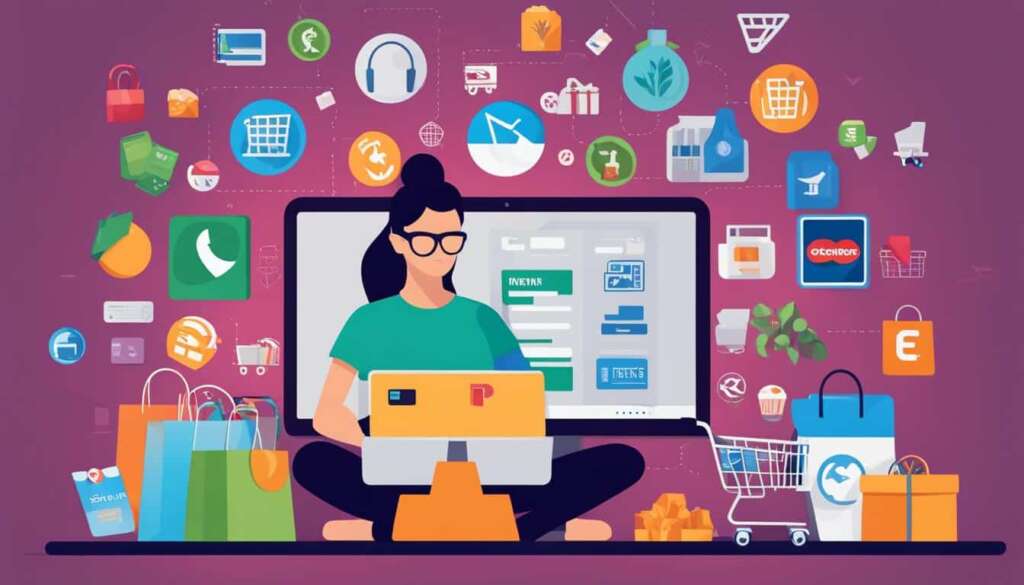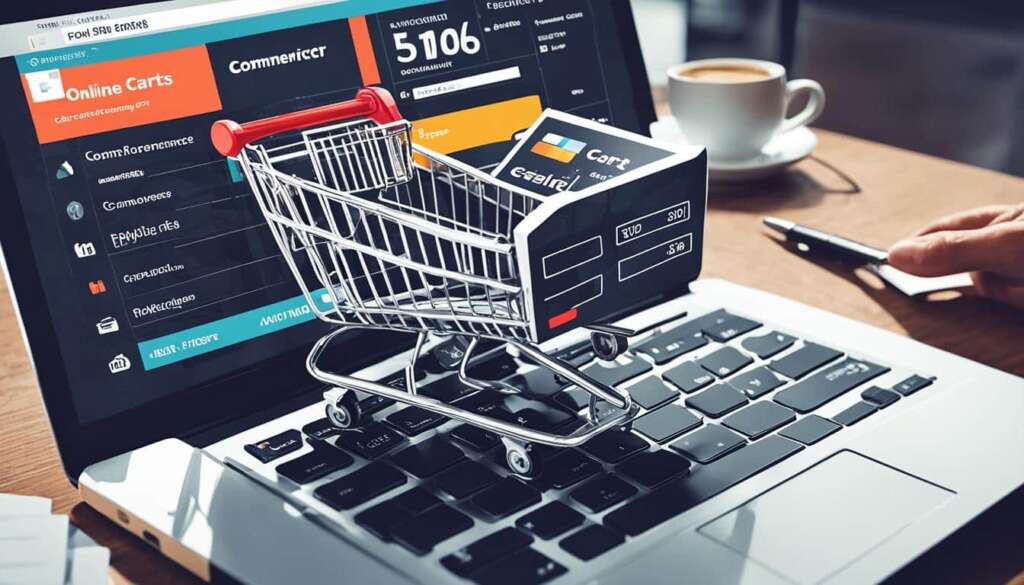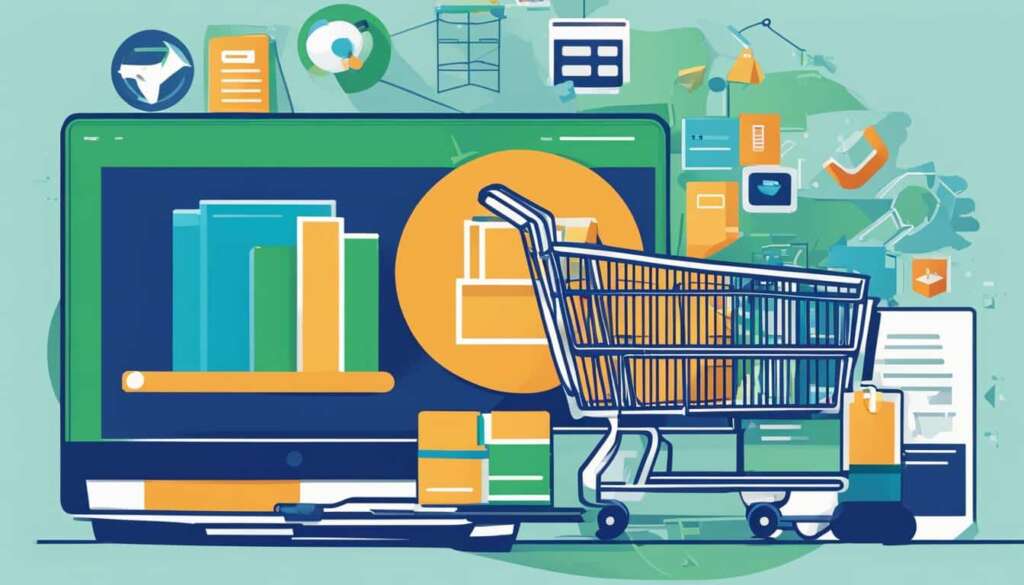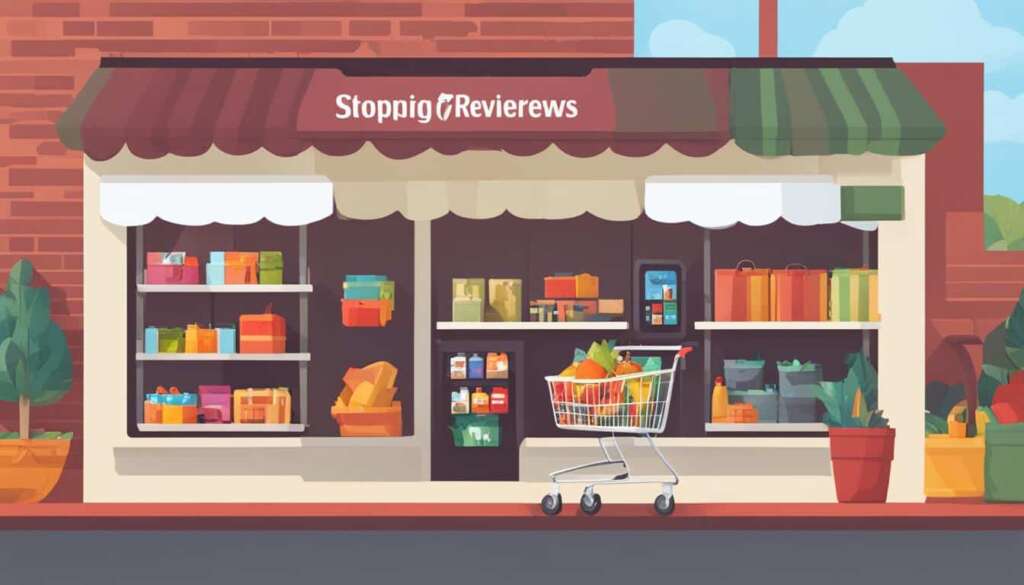Table of Contents
E-commerce, also known as electronic commerce, is a thriving industry encompassing the buying and selling of goods and services over the internet. It has revolutionized the way businesses operate, providing a platform for online retail to flourish. From large multinational corporations to small startups, e-commerce has become an integral part of the global economy.
The growth of e-commerce can be attributed to the popularity of platforms like Amazon and eBay, which have paved the way for online retail giants. In recent years, the COVID-19 pandemic has further accelerated the shift towards e-commerce, as physical stores faced restrictions and consumers turned to online shopping for convenience and safety.
E-commerce businesses have witnessed exponential growth, with online retail sales accounting for 15% of total retail sales today. This figure is expected to continue rising as more consumers embrace the ease and accessibility of shopping online.
In this article, we will delve deeper into the world of e-commerce and explore its different facets, from understanding what e-commerce is to how it works. We will also discuss the various types of e-commerce, highlighting the advantages and opportunities it brings to businesses and consumers alike.
What is E-commerce?
E-commerce, or electronic commerce, refers to the buying and selling of goods and services over the internet. It has become an integral part of the modern business landscape, providing convenience and accessibility for both consumers and businesses alike. With the rise of technology and the widespread use of the internet, e-commerce has experienced significant growth in recent years. Understanding the definition of e-commerce and its various types is crucial in navigating the dynamic world of online retail.
Types of E-commerce
E-commerce can be categorized into different types based on the nature of the transactions:
- B2B (Business-to-Business): This type of e-commerce involves transactions between businesses. It encompasses the buying and selling of products, services, and information between two or more companies. B2B e-commerce often involves larger order volumes and strategic partnerships.
- B2C (Business-to-Consumer): B2C e-commerce refers to transactions between businesses and individual consumers. It is the most common form of e-commerce and involves online retailers selling products or services directly to customers.
- C2C (Consumer-to-Consumer): C2C e-commerce enables consumers to directly trade products and services with each other. Online platforms act as intermediaries, facilitating transactions between individuals looking to buy and sell their goods or services.
- C2B (Consumer-to-Business): C2B e-commerce is when consumers offer products or services to businesses. This type of e-commerce allows individuals to sell their expertise, creative work, or unused assets, and businesses can buy from these individuals.
E-commerce transactions can take place through various channels, including online marketplaces, software-as-a-service (SaaS) tools, or open-source platforms. These platforms provide the infrastructure and functionality necessary for businesses to conduct their e-commerce operations efficiently.
E-tail: The Art of Online Retail
When it comes to e-commerce, one term that often comes up is “e-tail.” E-tail, short for electronic retail, specifically refers to the transactional processes involved in online retail shopping. It encompasses everything from browsing and product selection to order placement and fulfillment. Online retailers leverage e-tail strategies to enhance the customer experience and drive sales.
“E-tail involves creating a seamless and engaging online shopping experience for consumers. This includes displaying visually appealing product images, providing detailed product descriptions, offering secure payment options, and ensuring smooth order fulfillment and delivery.”
E-tail has revolutionized the retail industry, allowing businesses to reach a wider audience and provide customers with a convenient and personalized shopping experience. With the proliferation of mobile devices, consumers can now shop anytime, anywhere, further increasing the popularity and growth of e-tail.
How does E-commerce work?
E-commerce, also known as electronic commerce, relies on the internet as a platform for conducting business transactions. Customers access online stores using their own devices, such as smartphones, tablets, or computers. The e-commerce process involves several key steps, including order management and payment processing.
Order Management:
When a customer places an order on an e-commerce website, their web browser communicates with the server hosting the website. The order data is then relayed to the order manager, which coordinates the fulfillment of the order. The order manager interacts with inventory databases, ensuring that the requested products or services are available.
Payment Processing:
Once the order is validated and the necessary items are confirmed to be in stock, the payment processing stage begins. The order manager sends the order data to payment processing applications and the customer’s chosen payment gateway. The payment processing system securely collects the customer’s payment information and verifies the transaction’s validity. To ensure smooth and secure transactions, e-commerce businesses invest in robust payment processing systems.
After successful payment verification, the order manager notifies the web server, which then displays a confirmation message to the customer. The order data is subsequently sent to the warehouse or fulfillment department for product dispatch or service access.
E-commerce’s efficient and streamlined process allows customers to conveniently browse and purchase products or services from the comfort of their own homes. The order management and payment processing stages play essential roles in ensuring that orders are accurately processed and payments are securely transacted, enhancing the overall customer experience.
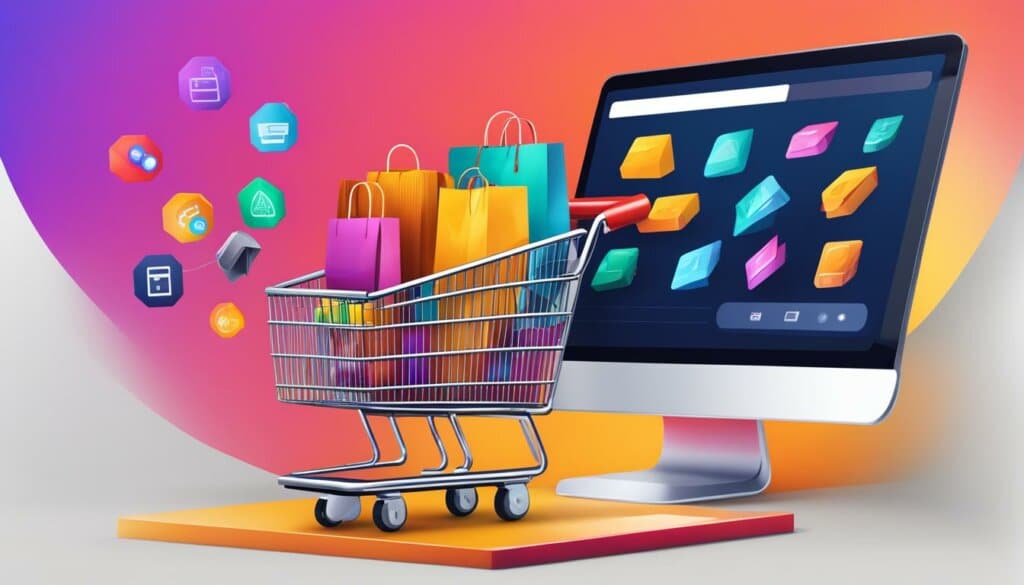
| Benefits of E-commerce Process | Order Management | Payment Processing |
|---|---|---|
| Increased efficiency | Centralized order tracking | Secure payment gateways |
| 24/7 availability | Real-time inventory management | Payment fraud prevention measures |
| Global reach | Automated order fulfillment | Multiple payment options |
| Reduced costs | Streamlined order processing | Seamless integration with third-party payment providers |
Types of E-commerce
E-commerce encompasses various business models, each catering to different types of transactions. Let’s explore the main types of e-commerce:
B2B E-commerce: Business-to-Business
B2B e-commerce refers to transactions that occur between businesses. In this model, businesses buy and sell goods or services to other businesses. B2B e-commerce platforms facilitate efficient procurement processes, allowing businesses to streamline their supply chains and improve operational efficiency.
B2C E-commerce: Business-to-Consumer
In B2C e-commerce, businesses sell products or services directly to consumers. This model is commonly associated with online retail platforms like Amazon and eBay. B2C e-commerce offers convenience and a wide range of options for consumers to browse, compare, and purchase products online.
D2C E-commerce: Direct-to-Consumer
D2C e-commerce eliminates the need for intermediaries or distributors. In this model, businesses sell their products directly to consumers. By bypassing traditional retail channels, D2C brands can connect with their target audience, maintain control over the customer experience, and gather valuable consumer insights.
C2C E-commerce: Consumer-to-Consumer
C2C e-commerce enables consumers to trade products and services with each other through online platforms. This model fosters peer-to-peer transactions, where individuals can sell their used or unused items to interested buyers. Popular C2C e-commerce platforms include eBay and Craigslist.
C2B E-commerce: Consumer-to-Business
In C2B e-commerce, consumers offer their products or services to businesses. This model is often seen in freelancing platforms, where businesses can hire individual professionals for specific tasks or projects. C2B e-commerce provides individuals with the opportunity to monetize their skills or assets.
B2A and C2A E-commerce: Business/Consumer-to-Administration
B2A e-commerce refers to transactions between businesses and public administration, while C2A e-commerce involves transactions between consumers and public administration. These models include online government services, such as tax payments, license renewals, and online bidding systems. B2A and C2A e-commerce streamline administrative processes, making them more efficient and accessible.
Understanding the different types of e-commerce is essential for businesses looking to establish or expand their online presence. Each model has its own unique characteristics and advantages, catering to specific target audiences and transactional needs.
Advantages of E-commerce
E-commerce brings numerous benefits to businesses and customers alike. In this section, we will explore the advantages that make e-commerce a preferred choice for many.
24/7 Availability
One of the key advantages of e-commerce is its 24/7 availability. Unlike physical stores that have limited opening hours, e-commerce websites are accessible to customers at any time of the day or night. This around-the-clock availability allows customers to browse and shop conveniently, regardless of their location or time zone.
Wide Selection
E-commerce platforms offer customers a vast array of products and services. With just a few clicks, customers can explore a wide range of options, often much greater than what physical stores can offer. This abundance of choices empowers customers to find exactly what they are looking for and compare various options, helping them make informed purchasing decisions.
International Reach
E-commerce eliminates geographical barriers, enabling businesses to reach customers globally. With an online presence, businesses can expand their customer base beyond their local area, tapping into new markets and opportunities. This international reach opens doors to increased sales and brand exposure, allowing businesses to thrive on a global scale.

“E-commerce eliminates geographical barriers, enabling businesses to reach customers globally.”
| Advantages of E-commerce | Description |
|---|---|
| 24/7 Availability | E-commerce websites are accessible to customers at any time, providing convenience and flexibility. |
| Wide Selection | E-commerce platforms offer a vast array of products and services, providing customers with abundant choices. |
| International Reach | E-commerce enables businesses to expand their reach globally, tapping into new markets and opportunities. |
Conclusion
E-commerce has experienced significant growth in recent years, and its upward trajectory shows no signs of slowing down. With global e-commerce sales estimated to reach an astounding £8 trillion by 2026, accounting for 23.6% of all retail activity, the future of e-commerce looks incredibly promising.
This growth can be attributed to various factors, including the rise of mobile commerce and the increasing adoption of digital technologies. As more consumers gravitate towards the convenience of shopping on their smartphones and tablets, businesses must adapt to meet these changing preferences. Embracing mobile-friendly websites and optimizing the overall user experience across all devices will be essential for e-commerce success in the future.
Furthermore, the ongoing advancements in technology create new opportunities and challenges for e-commerce businesses. The integration of artificial intelligence, virtual reality, and augmented reality into the e-commerce experience offers exciting possibilities to enhance customer engagement and personalization. Additionally, the expansion of cross-border e-commerce provides businesses with access to a global customer base, allowing them to tap into new markets and drive further growth.
To capitalize on the potential of e-commerce, businesses must continue to adapt, innovate, and stay ahead of the curve. By leveraging emerging technologies, staying informed about consumer trends, and consistently delivering exceptional customer experiences, e-commerce businesses can position themselves for long-term success in this rapidly evolving landscape.
FAQ
What is e-commerce?
E-commerce, or electronic commerce, refers to the buying and selling of goods and services over the internet. It encompasses various types of transactions, including business-to-business (B2B), business-to-consumer (B2C), consumer-to-consumer (C2C), and consumer-to-business (C2B).
What are the types of e-commerce?
The main types of e-commerce business models are B2B, B2C, D2C, C2C, C2B, B2A, and C2A. B2B e-commerce refers to transactions between businesses, while B2C e-commerce involves businesses selling products or services to consumers. D2C e-commerce is when a business sells directly to consumers without intermediaries or distributors. C2C e-commerce allows consumers to trade products and services with each other, facilitated through online platforms. C2B e-commerce is where consumers make their products or services available for businesses to bid on and purchase. B2A refers to transactions between businesses and public administration, while C2A involves transactions between consumers and public administration.
How does e-commerce work?
E-commerce operates through the internet, with customers using their own devices to access online stores. When a customer places an order, their web browser communicates with the server hosting the e-commerce website, relaying the order data to the order manager, inventory databases, payment processing applications, and the bank. After the order is validated, the order manager notifies the web server, which displays a message to the customer. The order data is then sent to the warehouse or fulfillment department for product dispatch or service access.
What are the advantages of e-commerce?
E-commerce offers several advantages, including 24/7 availability, allowing customers to browse and shop at any time. It provides a wide selection of products and services, often greater than physical stores, and enables businesses to reach customers globally. E-commerce also offers lower costs compared to running physical stores and allows for personalization and product recommendations based on customer data.
What is the future of e-commerce?
E-commerce has experienced substantial growth in recent years and is projected to continue expanding. Global e-commerce sales are estimated to reach $8 trillion by 2026, accounting for 23.6% of all retail activity. The rise of mobile commerce and the increasing adoption of digital technologies contribute to the growth of e-commerce. As technology continues to evolve, e-commerce businesses need to adapt and innovate to meet changing consumer expectations and stay competitive in the market.


